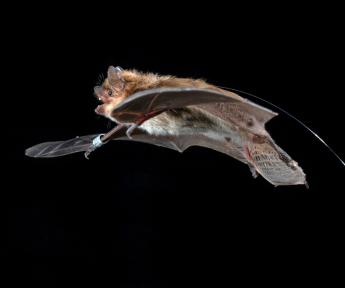Abstract
Globally, bats provide critical ecosystem services. Rabies, caused by rabies virus and related lyssaviruses, is one of the most significant zoonoses associated with bats. Bat biologists study bats in the laboratory and the field. To minimize the risk of disease, all bat handlers should be vaccinated against rabies and undergo routine serological testing to measure their rabies virus neutralizing antibody levels. They should use best practices to avoid exposures, such as personal protective equipment, especially gloves appropriate to the size of the bat(s) being handled. Attention to such details will prevent unnecessary exposures and avoid some of the accompanying negative perceptions that endanger bats on a global level. The small body sizes of many bats (<50 g, many <20 g) and small teeth makes their defensive bites easy to overlook. Breaks in the skin, however small, may result in exposure to lyssaviruses in the animals’ saliva. Exposure to blood-feeding bats is less common because these species are geographically restricted to the Neotropics and are the only species whose natural feeding behavior could involve transmission of rabies virus. Understanding viral transmission, preventing exposures, and responding appropriately to bites will minimize the consequences of this deadly zoonosis.
Introduction
The mammalian order Chiroptera is composed of ∼1500 species of extant bats (Simmons and Cirranello 2024). Bats are the only mammals capable of powered flight. The highest diversity of bats occurs in the tropics and subtropics. Wherever they occur, bats play critical roles in ecosystem services although these are often most apparent when populations decline (e.g., Frank 2024). Bats are fascinating animals and researchers the world over study them in the laboratory and field. Their attraction as subjects is longstanding as reflected by the many books about bats published over the past century (e.g., Allen 1939; Griffin 1958; Brosset 1966; Kunz and Parsons 2009; Fenton and Simmons 2015; Fenton and Rydell 2023). Human health risks associated with the study of bats and other wildlife can be mitigated by precautions around exposure to zoonotic viruses such as rabies lyssavirus (RABV) (Messenger et al. 2003).
Multiple lyssaviruses cause rabies (Table 1), a major viral zoonosis that can spill over to humans from other animals including humans (Warren and Sawyer 2023). This is an acute progressive neurological disease of mammals which, following the onset of illness, is almost invariably fatal because there is no proven treatment for it in any species. The clinical disease rabies is caused predominantly by RABV, a single-stranded, negative-sense, RNA virus in the family Rhabdoviridae (Kuhn et al. 2022). Rabies also is caused by at least 17 other putatitve lyssavirus species (Coertse et al. 2020), including Kotalahti bat lyssavirus which awaits formal classification, as well as Matlo bat lyssavirus, Taiwan bat lyssavirus 2, and Phala bat lyssavirus (Walker et al. 2022). In afflicted animal vectors, lyssaviruses are excreted in saliva. Bites are the main route of viral transmission. Besides bites or scratches, conspecific grooming and licks to open wounds may result in exposure from animals with high amounts of salivary viral shedding (Banyard et al. 2020; Gregory and Tinline 2020). Conventionally mucous membrane exposure involves recipient ocular, oral, rectal, or vaginal exposures.


